August 6, 1981
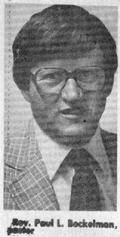
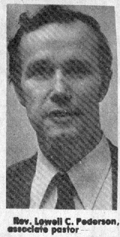
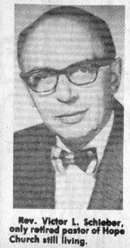
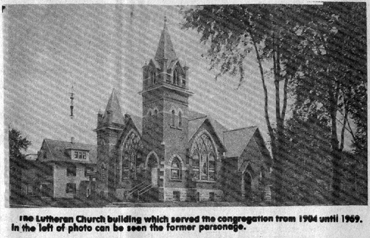
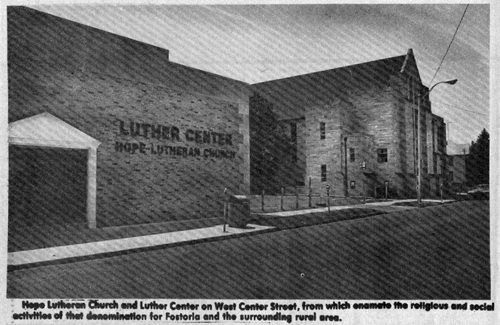
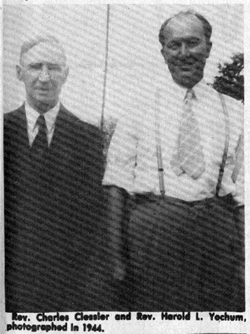
Picture #1 – Rev. Paul L. Bockelman, pastor
Picture #2 – Rev. Lowell C. Pederson, associate pastor
Picture #3 – Rev. Victor L. Schieber, only retired pastor of Hope Church still living.
Picture #4 – The Lutheran Church building which served the congregation from 1904 until 1969. In the left of photo can be seen the former parsonage.
It is a mark of distinction to reach the ago of 100.
It indicates that many storms have been weathered through that period of time. But to reach 113 years is still more honorable. That’s the age of Fostoria’s Hope Lutheran Church. It is the fourth church to be founded during this town’s early history, the earlier ones in order being, Methodist, St. Wendelin and Presbyterian.
It was before 1868 that a few German settlers who had come to America’s shores, and later migrated to this area, started to meet in the homes of local families of the same religious artisans in their native country and continued as such here.
Later the group rented space in the upstairs of the building at the corner of North and Main, which today stands vacant, but more recently was used by U.S. Employment Services.
In the early part of 1868, that small band of Christians called upon Rev. M. Buerkle, pastor of the Evangelical Lutheran Church in Findlay, to assist them in adopting a constitution and electing the necessary officers for officially organizing their church. The charter members of that group were: John Hoffman, William Windenweeder, John Reber, G. Merz, John Lutz, Louis Sahs, George Lemp, Henry Miller. Available records do not indicate the officers of the group, if any.
CHURCH BUILT IN 1869
In December 1868, the new congregation felt the need for a permanent place of worship, and purchased a lot at the northeast corner of Center and Countyline. That location is where the Fred Gerlinger family later resided for many years.
Construction on a new church building on that site was started in the spring of 1869, and completed and dedicated in September. The cost of the new church was $1,500.
Rev. Buerkle continued to serve the local congregation, as well as the Lutherans in Findlay, until 1875, when he resigned to give full time to the Findlay church. A pastor being unavailable for the Fostoria church, they united with the Zion congregation of Lutherans, led by Rev. William Braumworth. That group was located in Jackson Township, east of Fostoria. They had been organized Rev. Adolph Conrad in 1838 and used a log structure for both a school and a church until 1852, when a larger frame structure was built. Then in 1890, they erected a brick building (shown by one of the accompanying photos) which still stood and was used until sometime after 1952, when it was demolished, the Zion congregation having merged with the Fostoria church at that time.
At the corner of County Road 592 and 39 where the Zion Church once was, there still exists the parish cemetery and the cornerstone from the building; the grounds being properly maintained in respect for the church and the early Christians who fostered it.
Rev. Braumworth pastored the two churches only one year, and was followed by Rev. C.A. Damenden, who also stayed for only one year.
BILINGUAL SERVICES
Rev. C.A.J. Cramer accepted the pastorate in 1877 and remained until 1882. It was during his years that services were preached in English every other Sun- day, in as much as younger members had not learned German from their parents. The bilingual services continued for some years, then later German services were held only on Christmas, Good Friday and Thanksgiving, to please the old- er members who cherished their native German.
During that period, 1869-1900, the church at Center and Countyline was still in use, but had been enlarged, remodeled and a tower added for a bell, which was purchased and installed in 1875. (See Potluck article July 9, 1981).
Rev. George Dillman succeeded Rev. C.A.J. Cramer in 1882 and remained until 1916, a period of 34 years. For the first 24 years of his pastorate he served both the Hope and Zion churches, walking five miles to the Zion Church every Sunday, preaching at both places as well as conducting Sunday school. The last 10 years of his term was devoted exclusively to the Fostoria church.
NEW CHURCH IN 1904
It was during Dillman’s pastorate that the congregation outgrew their first church building and realized the necessity for a new one.
The present site of the church was purchased, and in May 1904, the building shown in an accompanying photo was dedicated.
When the Lutheran’s second church was built at Wood and Center, rather than demolish the first church at Center and Countyline, it was used to create the two houses which still stand on that site. Fred Gerlinger, a member of the congregation, now deceased, once owned both houses. Today, the corner one is owned by Mr. and Mrs. Robert Etzinger and the one beside it, at 350, is owned by Mr. and Mrs. John Burris.
In 1916 Dillman’s health failed, and it was necessary to resign. Rev. C.E. Clessler, so well remembered by many readers arrived to become the new pastor, staying for 28 years.
Chessler was a bachelor when he came to Fostoria, and so he remained. His sister, Louise, occupied the parsonage with him and served as housekeeper.
He was a well-known person about town, active in the Rotary Club and the YMCA, where he could often be found working out in the gym or swimming.
REV. CLESSLER 1916-44
I remember so well the story Clessler once told about his early experience as a young student preacher. He had prepared his sermon and made extensive notes for it. When he got up to preach he reached in his pocket for the notes, but they were not there. He said he was utterly lost, but somehow stumbled through the ordeal. Later he told one of his professors about the incident, and was advised that should be a good lesson…never to use notes, but commit the sermon to memory. Clessler said he had learned his lesson and took the advice.
Rev. Clessler’s health failed, causing him to resign in 1944. He died in January 1948 in Bucyrus, where he and his sister had moved, and burial was in Oak Ridge Cemetery.
Rev. Victor Schieber arrived to succeed Clessler in 1944, remaining as pastor until 1970, a period of 26 years. During his pastorate, the present church edifice was constructed at a cost of $145,000. Also during his term, the church celebrated their centennial in 1968.
The present pastor, Rev. Paul L. Bockelman, succeeded Scheiber in 1970. Since then, the property adjacent to the church was purchased and remodeled as an educational and fellowship unit, known as Luther Center. Also in 1978, on the 110th anniversary of the founding of the church, the records show that there had been 1,167 baptized, 881 confirmed and 678 communicant members.
Rev. Lowell C. Pederson, joined Hope Lutheran in 1978 as associate pastor. In that capacity he alternates with Rev. Bockelman in conducting preaching ser- vices, and also handles religious education, auxiliary organizations and youth activities.
PASTORS SERVED
The fact that Hope Lutheran Church has had only nine pastors during its 113 years, up to and including the present, seems to be another distinction worth of mention. It indicates a good relationship between pastor and congregation …between the “shepherd” and the “sheep.”
In a very real sense, the shepherd in the Bible lands possesses his sheep, and it may also be said that the sheep possess their shepherd.
A shepherd in the rugged parts of Lebanon was once asked if he knew each one of his sheep. He replied “If you blindfold me and bring to me any of my sheep, I can tell if it is my sheep by putting my hand on its face.”
The Lord Jesus felt this same close relationship with His followers when He said, “I know my sheep and am known of mine.”
Still another honor that should be credited to Hope Lutheran Church is the ordination of four members from the congregation as pastors in their denomination. They are: Rev. Earl Stainbrook; Rev. Henry Wolf, D.D.; Rev. Harold Yockum, D.D.; Rev. Harold Pember. Stainbrook is the only one still active in the ministry. Rev. Yochum is deceased. (See Potluck Aug. 13, 1978).
WORTH MENTION
When the new church was built in 1959 at a cost of $400,000, it was equipped with an organ manufacturing by Pels Organ Co. of Alkmaar, The Netherlands.
In keeping with today’s trend to use carillon chimes, not bells, Hope Lutheran was given a set in memory of Mr. and Mrs. Jacob Gerlinger, by daughter Mrs. Harry Uliciny, son Dr. T.V. Gerlinger, Mrs. David Haney and Dr. Lawton Ger- linger Jr.
Every day at 12:05 and 5:05 p.m. the chimes peal out their melodious music, which can be heard throughout the business district and much of residential areas.
Rev. Harry Wolf, one of those locally reared and ordained into the Lutheran ministry, spent some years as executive director of Lutheran Charities. In 1954, re routed Europe for two months studying how the church could assist in placing displaced persons and otherwise assisting them.
Author’s Note: Data for this article was taken in part from church history written in 1968 by Joan Colbert, and used for their Centennial booklet.